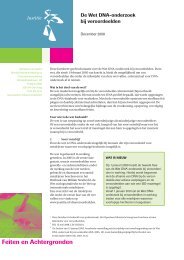INTERPOL HANDBOOK ON DNA DATA EXCHANGE AND PRACTICE
INTERPOL HANDBOOK ON DNA DATA EXCHANGE AND PRACTICE
INTERPOL HANDBOOK ON DNA DATA EXCHANGE AND PRACTICE
You also want an ePaper? Increase the reach of your titles
YUMPU automatically turns print PDFs into web optimized ePapers that Google loves.
INTRODUCTI<strong>ON</strong>by ronald k. noblethe secretary general of interpolGlobalization and advances in technology allow criminals to commit crimes acrossinternational borders with greater ease than ever before. With criminal methods andtactics changing continuously, the tools used to fight crime also need to keep pace.One area where cutting-edge developments have emerged is that of the use of <strong>DNA</strong>evidence, meaning that ethics and best practice of <strong>DNA</strong> profiling now need to beaddressed on a global scale. At <strong>INTERPOL</strong>, we are doing just that; assisting the lawenforcement and forensic community by supporting, facilitating, and promoting the useof <strong>DNA</strong> analysis on a national, regional and international level.In order to meet the growing need for <strong>INTERPOL</strong> member countries to exchangeand compare <strong>DNA</strong> profiles, we have developed several <strong>DNA</strong> data-sharing tools,known collectively as the <strong>INTERPOL</strong> <strong>DNA</strong> Gateway. These include an international<strong>DNA</strong> Database, an international search request form for bilateral exchange and ameans for secure standardized electronic transfer. Since the introduction in 2003 ofthe <strong>INTERPOL</strong> <strong>DNA</strong> Database, over 50 member countries have contributed profilesfor international searches and storage. This number is remarkable given that today nomore than 54 member countries operate a national <strong>DNA</strong> Database. However, thesetools cannot function in isolation, which is why we back up our high-tech data exchangesystems with promotional workshops, <strong>DNA</strong> conferences and resources such as thispublication.The <strong>INTERPOL</strong> Handbook on <strong>DNA</strong> Data Exchange and Practice was first publishedin 2001. Translated into seven different languages, and available via the Internet andseveral intranet channels, it has become popular with investigators all over the world.Since its initial publication, the number of national <strong>DNA</strong> Databases in existence hasmore than doubled, and techniques, standards, applications and experiences in all fieldsrelating to <strong>DNA</strong> profiling have changed considerably. In response, the <strong>INTERPOL</strong> <strong>DNA</strong>Monitoring Expert Group has reviewed and updated the Handbook, with the aim ofproviding state-of-the-art recommendations to police and forensic science servicesand maximizing the benefits of using <strong>DNA</strong> profiling techniques worldwide. It is ourhope that this handbook will help define global standards in relation to <strong>DNA</strong> profilingand will further enhance the capabilities of <strong>INTERPOL</strong> member countries.Lastly, I would like to thank everyone who has contributed to this manual, makingit an essential reference for investigators across the world, and to encourage anyfeedback. Your comments, experience and professional insight will help us keep the<strong>INTERPOL</strong> Handbook on <strong>DNA</strong> Data Exchange and Practice as up-to-date and relevantas possible.introduction PAGE 5







